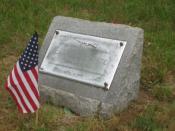 Please log in to see the coordinates.
Please log in to see the coordinates.
 Cache attributes
Cache attributes





 Description
EN
Description
EN
CHARLES L. WHITE
31 May 1926 - 19 April 1945
Company L, 180th Regiment, 45th Division Thunderbirds
Killed in Action in the Capture of the German Fortress at Nurenburg
42 days shy of his 19th birthday and only 19 days before the end of World War II
LOGGING REQUIREMENTS:
1. Visit the site in-person.
2. Locate the marker for Charles L. White. Face west. In a direct line, the first head stone you see, is for someone with the name of a major historic figure and his wife. The Log Password is the husband's full name (First Middle Initial Last, with no spaces or punctuation).
3. Please post a picture of your visit that does not include the Log Password information.
Nuremberg held great significance during the Nazi era in Germany, partly because of the city's relevance to the Holy Roman Empire and its position in the centre of Germany. During World War II, Nuremberg was the headquarters of Wehrkreis (military district) XIII, and an important site for military production, including aircraft, submarines, and tank engines. A subcamp of Flossenbürg concentration camp was located here. Extensive use was made of slave labour. The city was severely damaged in Allied strategic bombing from 1943–45. On 2 January 1945, the medieval city centre was systematically bombed by the Royal Air Force and the U.S. Army Air Forces and about ninety percent of it was destroyed in only one hour, with 1,800 residents killed and roughly 100,000 displaced. In February 1945, additional attacks followed. In total, about 6,000 Nuremberg residents are estimated to have been killed in air raids.
The United States, United Kingdom, France and Canada jointly invaded Germany from the west on 8 February 1945. By 16 April, the 7th Army had begun its assault on Nuremberg. By the end of the day, the Americans had captured the outskirts of Erlenstegen and Buch. By 17 April, the 7th Army captured the marshaling yard and the surrounding area as well as the neighborhoods of Veilhofstrasse and Woehrd. By evening, the airport to the north was captured and US artillery began to shell the old city. American troops met fierce resistance around the old city on 18 April, which destroyed many buildings around the old city, including damaging the historic city castle. And, as American artillery continued to shell the old city, US troops reach the old city via Burgschmietstrasse.
On 20 April, the 3rd Infantry Division and the 45th Infantry Division lay siege to the old city. German resistance was so great that American heavy artillery and air support was deployed. Late that night, all German troops surrendered. On the evening of 20 April, the American flag was hoisted at Adolf Hitler Platz, formally ending the battle.
This cache was inspired by our BSA Troop 424's "We Remember" outing to Grace Cemetery in Savage, MD the week prior to Memorial Day. One of our Assistant Scoutmasters did some research on the Allied attack on Nuremberg in April 1945 and shared the story of the attack with the troop, before we placed the flag at this headstone.
Join Geocachers Unlimited on Facebook.
 Additional hints
Additional hints
 Pictures
Pictures
 Log entries:
Log entries:
 5x
5x
 0x
0x
 0x
0x




 Rated as: n/a
Rated as: n/a







